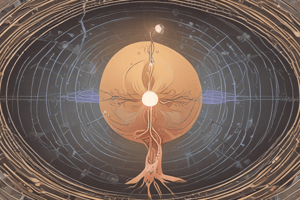Podcast
Questions and Answers
The lining of the bladder is made up of cells called urothelium.
The lining of the bladder is made up of cells called urothelium.
True (A)
Smokers are twice as likely to develop bladder cancer as non-smokers.
Smokers are twice as likely to develop bladder cancer as non-smokers.
False (B)
A cystoscopy is used to examine the bladder lining for abnormalities.
A cystoscopy is used to examine the bladder lining for abnormalities.
True (A)
Blood in the urine is always visible to the naked eye in cases of bladder cancer.
Blood in the urine is always visible to the naked eye in cases of bladder cancer.
Early-stage bladder cancer is often treated with radiation therapy.
Early-stage bladder cancer is often treated with radiation therapy.
Bladder cancer is considered the most common type of cancer.
Bladder cancer is considered the most common type of cancer.
A retrograde pyelogram is a type of imaging test used to diagnose bladder cancer.
A retrograde pyelogram is a type of imaging test used to diagnose bladder cancer.
A radical cystectomy involves the removal of only a portion of the bladder.
A radical cystectomy involves the removal of only a portion of the bladder.
Flashcards
Bladder Cancer
Bladder Cancer
A disease affecting the bladder lining that can form tumors.
Urothelium
Urothelium
The type of cells lining the bladder that stretch and contract.
Risk Factors
Risk Factors
Conditions that increase the likelihood of developing bladder cancer.
Symptoms of Bladder Cancer
Symptoms of Bladder Cancer
Signup and view all the flashcards
Cystoscopy
Cystoscopy
Signup and view all the flashcards
Biopsy
Biopsy
Signup and view all the flashcards
Treatment for Early Bladder Cancer
Treatment for Early Bladder Cancer
Signup and view all the flashcards
Advanced Bladder Cancer
Advanced Bladder Cancer
Signup and view all the flashcards
Study Notes
Bladder Cancer Overview
- Bladder cancer affects the lining (urothelium) of the bladder, a hollow organ storing urine.
- Urothelial cells stretch and contract as the bladder fills and empties.
- Mutations in these cells can lead to abnormal growth and bladder tumors.
Risk Factors
- Smoking: Smokers are three times more likely to develop bladder cancer due to tobacco smoke's toxic components damaging the bladder.
- Age: Individuals over 55 are at increased risk.
- Gender: Men are more prone than women.
- Exposure to chemicals: Contact with toxic chemicals increases risk.
- Previous cancer treatment: Prior cancer treatment can be a risk factor.
- Chronic bladder inflammation: Inflammation in the bladder increases risk.
- Family history: A family history of bladder cancer increases the risk.
Symptoms
- Blood in the urine: Visible or detectable via tests is the most common symptom.
- Frequent urination: A symptom of potential bladder issues.
- Painful urination: A symptom signaling potential issues.
- Back pain: Might be associated with urinary tract problems.
Diagnosis
- Cystoscopy: A thin camera inserted through the urethra to examine the bladder.
- Biopsy: Sample taken from suspicious growth for microscopic analysis.
- Urine cytology: Analysis of urine sample for cancer cells.
- Imaging tests: CT urogram or retrograde pyelogram, using dye for X-ray visualization.
Treatment
- Treatment approach depends on stage: Stage indicates the extent of cancer spread.
- Early-stage: Surgery to remove tumor, followed by chemotherapy or immunotherapy.
- Advanced-stage: More aggressive treatments such as radical cystectomy (bladder removal), chemotherapy, and immunotherapy might be necessary.
Key takeaway
- Bladder cancer is relatively uncommon.
- Early detection and treatment are crucial for positive outcomes.
- Consult a doctor for any concerns.
Studying That Suits You
Use AI to generate personalized quizzes and flashcards to suit your learning preferences.




